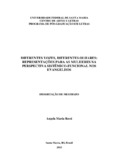| dc.creator | Rossi, Angela Maria | |
| dc.date.accessioned | 2015-10-07 | |
| dc.date.available | 2015-10-07 | |
| dc.date.issued | 2015-02-26 | |
| dc.identifier.citation | ROSSI, Angela Maria. Different voices, different views: representations for women in systemic functional perspective in the gospels. 2015. 163 f. Dissertação (Mestrado em Letras) - Universidade Federal de Santa Maria, Santa Maria, 2015. | por |
| dc.identifier.uri | http://repositorio.ufsm.br/handle/1/9927 | |
| dc.description.abstract | The Bible is the most translated book in the world. Such popularity and importance conquered by the Bible became perennial, making the stories told in its books perpetuate on social relations, interact with its readers and even guide them in the way of acting and/or thinking in relation to the values of life, to things and people. From this point and considering that language, besides having the socialization function, allows representing the world, ourselves and others, this study presents the analysis of 21 texts that make up the four Gospels of the New Testament. The language of these texts is studied in order to highlight representations for women by the transitivity system and the attitude subsystem. Therefore, the fundamental theoretical assumptions used are the notion of genre and register by Martin and Rose (2012), the concept of contextual variables by Halliday (1989), the lexico-grammatical categories of the transitivity system of Systemic Functional Grammar by Halliday and Matthiessen (2004), the semantic categories of Appraisal System by Martin and White (2005). The results show that concerning gender the Gospels can be considered biographical accounts, since they are testimonies of episodes from the life of Jesus Christ in the first century. In relation to the contextual variables, the analysis showed similarities and differences with regard to social situations of production of the Gospels in the context of each author. With regard to the linguistic analysis, the lexico-grammatical functions and the affectionand judgment marks point to eight representations for women. In the voices of the Pharisees, scribes, Sadducees and Evangelists, women are represented as properties, sinful, adulterous and discriminated. In the voices of the Evangelists and Jesus Christ, we noticed representations of them as partners, humble, devoted and courageous women. | eng |
| dc.format | application/pdf | por |
| dc.language | por | por |
| dc.publisher | Universidade Federal de Santa Maria | por |
| dc.rights | Acesso Aberto | por |
| dc.subject | Linguística sistêmico-funcional | por |
| dc.subject | Representações | por |
| dc.subject | Mulheres | por |
| dc.subject | Evangelhos | por |
| dc.subject | Systemic functional linguistics | eng |
| dc.subject | Women | eng |
| dc.subject | Representations | eng |
| dc.subject | Gospels | eng |
| dc.title | Diferentes vozes, diferentes olhares: representações para as mulheres na perspectiva sistêmico-funcional nos evangelhos | por |
| dc.title.alternative | Different voices, different views: representations for women in systemic functional perspective in the gospels | eng |
| dc.type | Dissertação | por |
| dc.description.resumo | A Bíblia é o livro mais traduzido do mundo. Tamanha popularidade e importância tornaram-na perene, fazendo com que as histórias contadas em seus livros perpetuem-se nas relações sociais, interajam com seus leitores e até mesmo os guiem na forma de agir e/ou pensar em relação aos valores da vida, às coisas e às pessoas. Partindo disso e considerando que a linguagem, além de apresentar a função de socialização dos indivíduos, possibilita fazer representações acerca do mundo, de nós mesmos e dos outros, este estudo apresenta a análise de 21 textos que compõem os quatro Evangelhos do Novo Testamento. A linguagem desses textos é estudada com o objetivo de evidenciar representações para as mulheres por meio da análise do sistema de transitividade e do subsistema de atitude. Para isso, os pressupostos teóricos fundamentais utilizados são as noções de gênero e registro de Martin e Rose (2012), as variáveis contextuais de Halliday (1989), categorias léxico-gramaticais do sistema de transitividade da Gramática Sistêmico-Funcional de Halliday e Matthiessen (2004) e categorias semânticas do Sistema da Avaliatividade de Martin e White (2005). Os resultados evidenciam que, no que tange ao gênero, os Evangelhos podem ser considerados relatos biográficos, pois são testemunhos sobre episódios da vida de Jesus Cristo no século I. Em relação às variáveis contextuais, a análise apresentou semelhanças e diferenças no que se refere às situações sociais de produção dos Evangelhos no contexto de cada autor. No que diz respeito à análise linguística, as funções léxico-gramaticais desempenhadas e as marcas de afeto e julgamento apontam oito representações para as mulheres. Nas vozes dos fariseus, escribas, saduceus e evangelistas, as mulheres são representadas como posses, pecadoras, adúlteras e discriminadas. Nas vozes dos evangelistas e de Jesus Cristo, foram evidenciadas representações de companheiras, humildes, devotas e corajosas. | por |
| dc.contributor.advisor1 | Fuzer, Cristiane | |
| dc.contributor.advisor1Lattes | http://lattes.cnpq.br/5169963931397212 | por |
| dc.contributor.referee1 | Silva, Edna Cristina Muniz da | |
| dc.contributor.referee1Lattes | http://lattes.cnpq.br/3082159562604784 | por |
| dc.contributor.referee2 | Cabral, Sara Regina Scotta | |
| dc.contributor.referee2Lattes | http://lattes.cnpq.br/9037816308995897 | por |
| dc.creator.Lattes | http://lattes.cnpq.br/4935031772898811 | por |
| dc.publisher.country | BR | por |
| dc.publisher.department | Letras | por |
| dc.publisher.initials | UFSM | por |
| dc.publisher.program | Programa de Pós-Graduação em Letras | por |
| dc.subject.cnpq | CNPQ::LINGUISTICA, LETRAS E ARTES::LETRAS | por |


